Meet the Alex f1 cucumber hybrid and learn to grow it correctly
Alex f1 is an early maturing Dutch hybrid for indoor and outdoor use. Differs in a high yield of marketable products, about 94%. Less than a month after planting, the first fruits appear. Cucumbers are short-fruited, of the same size, do not outgrow, even if they are not removed from the bush in time. Fruiting lasts until mid-October.
In the article, we will talk about the nuances of growing a "Dutchman" in the climatic conditions of our country, methods of dealing with downy mildew and insect pests.
The content of the article
Description of the hybrid
Cucumber Alex f1 - a breeding product of the Dutch company Bejo Zaden.
The culture is characterized by early ripening and long-term fruiting, until mid-October. The bushes are indeterminate, medium-sized, medium-growing, with female-type flowers. 4–6 ovaries are formed at the nodes. The fruits ripen together, resembling Adam f1 cucumbers from Bejo Zaden.
In the photo, hybrid cucumbers.
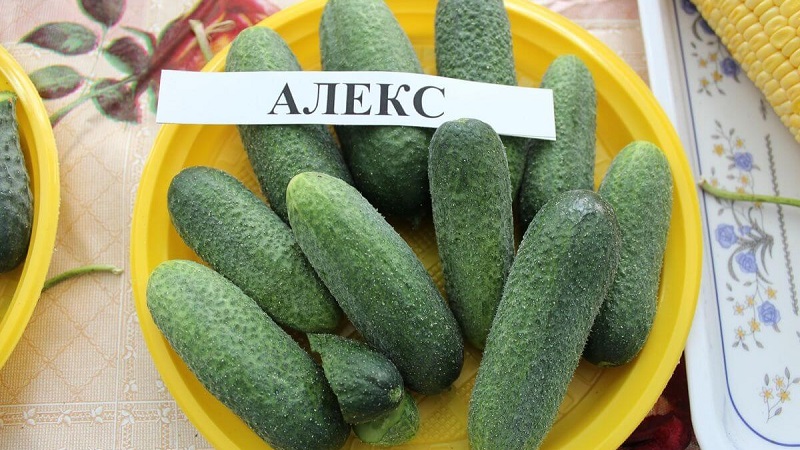
Distinctive features of Alex:
| Indicators | Characteristic |
| Ripening period | 38-42 days |
| Pollination type | Parthenocarpic |
| Weight | 70-90 g |
| Length | 9-11 cm |
| The form | Cylindrical |
| Coloration | Green or dark green with short stripes and slight mottling |
| Leaves | Small green and dark green |
| Pulp | Crispy juicy |
| Taste | Sweetish without bitterness |
| Skin | Dense, small tuberous, with dense white pubescence |
| Appointment | Universal |
| Yield | 2.8-5.7 kg / m², for the first 10 days of collection - 1.6 kg / m² |
| Sustainability | For cucumber mosaic virus, powdery mildew and olive spot |
| Transportability | High |
Composition, calorie content and benefits
Nutritional value of cucumbers (per 100 g):
- calorie content - 14 kcal;
- proteins - 0.8 g;
- fats - 0.1 g;
- carbohydrates - 2.5 g;
- water - 95 g;
- fiber - 1 g.
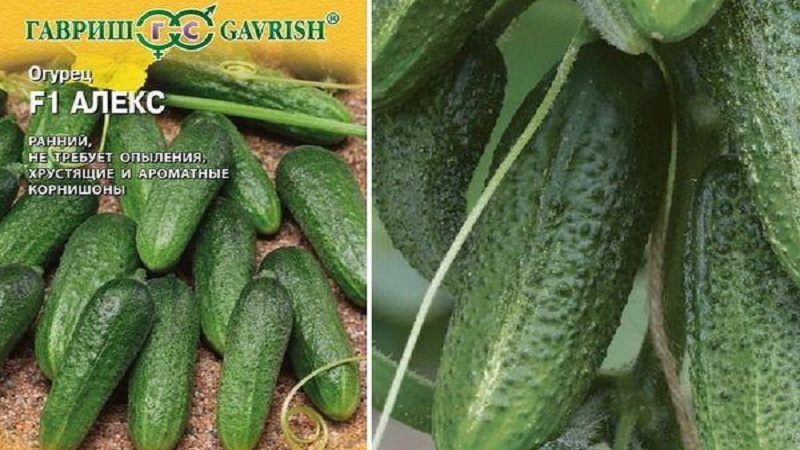
Vitamin and mineral composition table:
| Name | Content | Norm |
| Vitamin A | 10 mcg | 900 mcg |
| Beta carotene | 0.06 mg | 5 mg |
| Vitamin B1 | 0.03 mg | 1.5 mg |
| Vitamin B2 | 0.04 mg | 1.8 mg |
| Vitamin B4 | 6 mg | 500 mg |
| Vitamin B5 | 0.27 mg | 5 mg |
| Vitamin B6 | 0.04 mg | 2 mg |
| Vitamin B9 | 4 μg | 400 mcg |
| Vitamin C | 10 mg | 90 mg |
| Vitamin E | 0.1 mg | 15 mg |
| Vitamin H | 0.9 μg | 50 mcg |
| Vitamin K | 16.4 μg | 120 mcg |
| Vitamin PP | 0.3 mg | 20 mg |
| Potassium | 141 mg | 2500 mg |
| Calcium | 23 mg | 1000 mg |
| Silicon | 53 mg | 30 mg |
| Magnesium | 14 mg | 400 mg |
| Sodium | 8 mg | 1300 mg |
| Sulfur | 6.5 mg | 1000 mg |
| Phosphorus | 42 mg | 800 mg |
| Chlorine | 25 mg | 2300 mg |
| Iron | 0.6 mg | 18 mg |
| Iodine | 3 μg | 150 mcg |
| Cobalt | 1 μg | 10 mcg |
| Manganese | 0.18 mg | 2 mg |
| Copper | 100 mcg | 1000 mcg |
| Molybdenum | 1 μg | 70 mcg |
| Selenium | 0.3 μg | 55 mcg |
| Fluorine | 17 mcg | 4000 mcg |
| Chromium | 6 μg | 50 mcg |
| Zinc | 0.215 mg | 12 mg |
Benefits for the body:
- restoration of water balance;
- acceleration of metabolism;
- cleansing of blood vessels;
- normalization of pressure;
- lowering the level of "bad" cholesterol;
- whitening and moisturizing the skin;
- regulation of the pancreas.
Agrotechnics
The culture is grown mainly through direct sowing into the ground... Some farmers still use seedlings, and then dive them to a permanent place. Cultural agrotechnology is standard. To get stable high harvest and to minimize the contamination of plantings by fungi and bacteria, frequent loosening, weeding, moderate watering and feeding with organic matter and minerals are carried out.
Direct seeding
Cucumbers love fertile loamy and breathable soil... If the crop rotation is observed and the soil is saturated with nitrogen, phosphorus, potassium and humates, high productivity can be achieved.It is much easier to maintain soil fertility in open-air areas than in a greenhouse.
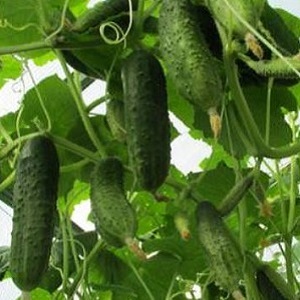 In protected ground, cultures are swapped: the land is quickly depleted, pathogenic flora accumulates in it, which is not always possible to destroy when treated with pesticides. Changing the topsoil and replacing it with a new one rectifies the situation, but this method is laborious and expensive.
In protected ground, cultures are swapped: the land is quickly depleted, pathogenic flora accumulates in it, which is not always possible to destroy when treated with pesticides. Changing the topsoil and replacing it with a new one rectifies the situation, but this method is laborious and expensive.
Quickly restore soil fertility in the greenhouse oats, white mustard, oil radish and legumes. Siderates increase the level of nitrogen, potassium and phosphorus, inhibit the development of fungi and bacteria. Indoors, plants are sown in the fall. For a month, they quickly gain green mass. They are mown and buried in the ground. Microbiological preparations "Vostok-EM" or "Baikal-EM" accelerate decay.
Sowing in the garden siderates (clover, lupine, oats, beans, peas) start in March – April. Plants make the soil loose and fertile. Often they mulch the beds.
The early ripening of the hybrid Alex f1 allows you to sow plants in the ground... They do this in May – June, depending on the region of growth. The minimum soil temperature is +16 ° С, air temperature is +20 ° С.
Important! The seeds are pre-processed in production, so no additional manipulations are required.
The land on the site is loosened and fertilized with chicken manure (10 l / m²). The beds are formed with a bayonet shovel and leveled with a rake. Sowing depth corresponds to half of the shovel bayonet... The depressions are spilled with a hot dark solution of potassium permanganate, sprinkled with wood ash. Seeds are planted at a distance of 20-25 cm and sprinkled with moist peat.
The beds are covered with agrofibre to protect against frostmaintaining optimum humidity. After the emergence of seedlings, the shelter is removed and the seedlings are thinned out. Weak shoots are pinched at ground level, strong ones are left.
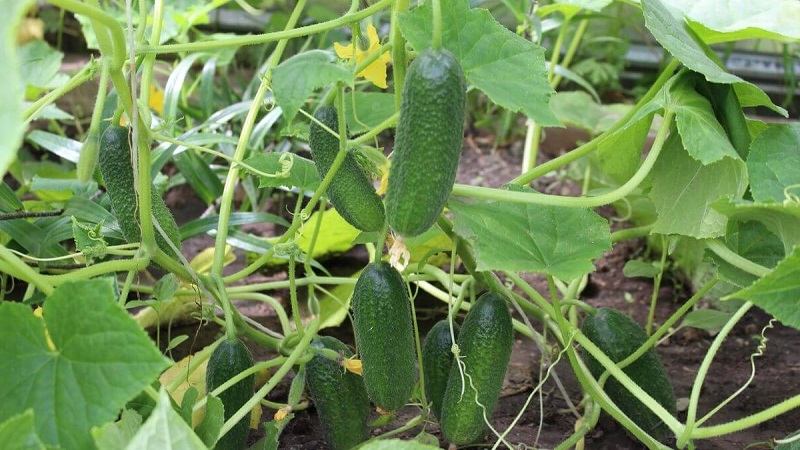
Growing seedlings
Seedlings of cucumbers begin to grow 3-4 weeks before the proposed pick to a permanent place.
The soil mixture is prepared from 2 parts of humus and pus, 1 part of river sand or sawdust. The components are mixed in a large bucket and poured with "Fitosporin-M" solution or potassium permanganate. Peat containers with a volume of 500 ml are filled with a wet substrate, 2 seeds are sealed to a depth of 1-2 cm. A film is pulled from above, the containers are placed in a warm place.
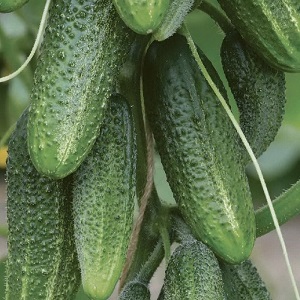 After the sprouts appear, the film is removed, the seedlings are taken out on a lighted windowsill. If necessary, the seedlings are illuminated with fluorescent lamps.
After the sprouts appear, the film is removed, the seedlings are taken out on a lighted windowsill. If necessary, the seedlings are illuminated with fluorescent lamps.
The culture is examined as it grows: Weak shoots are pinched (cut with scissors), but not pulled out, so as not to damage the root system. Pour abundantly with clean water at room temperature. Frequency - once a week.
Seedlings dive to a permanent place at the stage of 4 true leaves, after warming up the soil to at least +16 ° С, air - up to +20 ° С. Planting scheme - 20x60 cm, 4-5 bushes per 1 m². The roots are spud, lightly tamped the soil and watered abundantly with water.
Care
Crop care rules:
- Maintaining the air temperature in the greenhouse at the level of + 22 ... + 25 ° С, humidity - 80–85%.
- Watering plants with warm water under the root in the morning and evening or organization of drip irrigation.
- Soil mulching with hay, straw, sawdust.
- Regular loosening and weeding of the beds.
- Forming the bushes, according to the rules for parthenocarpics, and tying to the trellis.
- Feeding with organics and minerals 4-5 times per season. Particular attention is paid to the fruiting period.
- Timely harvest to maintain productivity.
Hybrid feeding scheme:
| Stage of development | Fertilizer |
| Before flowering | Dissolve 100 g of compressed yeast in 10 l of water, leave in a warm place. After 3 days, stir and pour over the cucumbers. Consumption - 500 ml per 1 bush. |
| During flowering | 15 g of ammonium nitrate, 30 g of superphosphate, 15 g of potassium sulfate per 10 liters of water. Consumption - 10 liters per 1 m². |
| 5 tsp boric acid, potassium permanganate on the tip of a knife for 5 liters of water. Spray the bushes in the evening. | |
| During fruiting | Infusion of nettle or tomato tops (1:15). Water at the root. Consumption - 5 l / m². |
| 50 g of urea per 10 liters of water. Treat bushes in the evening. | |
| 200 g of wood ash per 10 liters of water. Consumption - 10 l / m². |
Reference!Cucumbers are fed with root fertilizers in dry, sunny weather, foliar - in cloudy weather.
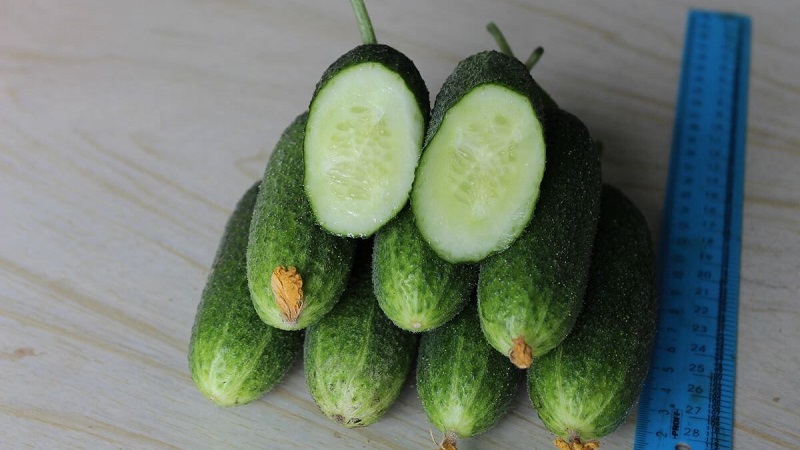
Features of cultivation and possible difficulties
To support the productivity of plants, they are formed by regulating the growth of leaves and lashes... Parthenocarpics tend to quickly gain green mass: if you do not pinch the lashes, the yield will be lower, all their strength will be spent on the formation of foliage and shoots, and not fruits.
Forming rules:
- blind (remove shoots and flowers) in the axils of the first 5 sheets;
- leave 6 lateral shoots 20-25 cm long;
- pinch a few shoots higher, leaving 35–40 cm each;
- fix the main stem on the trellis by pinching the top, or wrap it around the crossbar several times.
Diseases and pests
Hybrid Alex is resistant to virus cucumber mosaic, powdery mildew and olive spot, tolerant of downy mildew (peronosporosis).
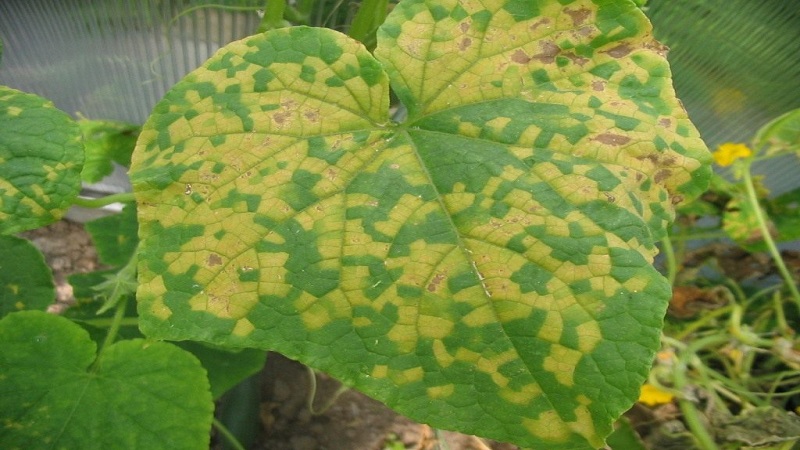
Signs of the disease:
- small brownish-yellow spots on the leaves;
- gray-purple bloom on the back;
- yellowing of green mass, general wilting of the plant.
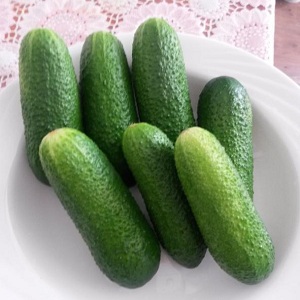 Due to the early maturation of the culture, the fight against the fungus is complicated. Fungicides are prohibited during this period. Prevention is a reliable way to preserve the crop. To do this, carry out the following measures:
Due to the early maturation of the culture, the fight against the fungus is complicated. Fungicides are prohibited during this period. Prevention is a reliable way to preserve the crop. To do this, carry out the following measures:
- disinfection of soil with copper sulfate (50 g of powder per 10 liters of water) or Fitosporin;
- loosening and weeding of beds;
- removal of infected plants;
- compliance with crop rotation;
- spraying plantings with fermented milk products with iodine (10 drops per 1 liter);
- feeding with vitamin complexes: "Energenom Extra", "Novosil".
Preventive treatment is carried out from the moment the flowers appear until the end of the growing season... Fermented milk products (kefir, milk whey, yogurt) are used once every 10 days so as not to acidify the soil.
Cucumbers are often affected by melon aphids, spider mites, whiteflies and slugs... To combat insects, folk remedies are used:
| Pest | Signs | Treatment |
| Spider mite | Small white dots on the back of leaves, thin cobweb on bushes. | 300 g of horse sorrel per 10 liters of water, leave for 4 hours and process the bushes. Spray the planting once every 10 days. |
| Aphid | Drooping leaves, drops of honeydew, a large concentration of ants. | Grind 1 kg of aloe tree and pour 10 liters of water, add 50 g of shavings of laundry soap. Spray plantings once a week. |
| Whitefly | Sticky bloom on stems and leaves, many white larvae at an early stage, white moths at a later stage. | 30 g of pepper, 200 g of tobacco shag per 10 liters of water. After a day, strain and add 25 g of liquid soap, 120 g of ash. Consumption for 1 m² - 3 liters of infusion. |
| Slugs | Shiny slime on the leaves, holes in the cucumbers. | A solution of ammonia (4 tablespoons per 10 liters of water) for spraying bushes. Manual collection of pests at night. |
Harvesting and application of the crop
Harvested about 40 days after full germination... Cucumbers are removed every 2 days. The fruits do not outgrow, do not barrel, but their regular collection supports further fruiting.
Like all parthenocarpics, Alex hybrid cucumbers are not bitter, have a firm crunchy flesh without voids. Ideal for fresh consumption and canning.
When assembled, they are stored for about 3 weeks in a cool place, do not turn yellow, tolerate transportation well.
Advantages and disadvantages
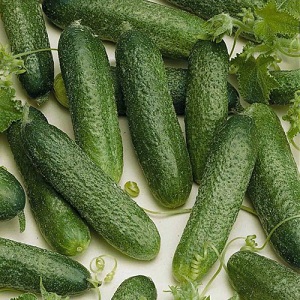 Hybrid advantages:
Hybrid advantages:
- early maturity;
- short-term fertility;
- lack of bitterness in taste;
- keeping quality;
- prolonged fruiting;
- versatility in cooking;
- the possibility of growing everywhere;
- plants do not need additional pollination by bees.
Disadvantage - the need to form bushes by blinding.
Reviews
Hybrid Alex was highly praised by gardeners for excellent taste of vegetables, unpretentious care and long-term fruiting.
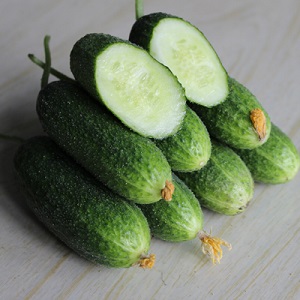 Ivan, Vyksa: “I've been growing the hybrid Alex for a long time. The result is always pleasing. Crop care is minimal. I installed drip irrigation in the greenhouse, I combine humidification with liquid mineral dressings. I form the bushes into 1 stem. Cucumbers never got sick with anything ".
Ivan, Vyksa: “I've been growing the hybrid Alex for a long time. The result is always pleasing. Crop care is minimal. I installed drip irrigation in the greenhouse, I combine humidification with liquid mineral dressings. I form the bushes into 1 stem. Cucumbers never got sick with anything ".
Irina, Balakhna: “Last season, Alex discovered cucumbers for herself. I grow vegetables for myself in a summer cottage. Planted through seedlings: it's more reliable. I did not process the seeds. She planted it at the end of May, and picked the first cucumbers at the end of June. I liked the taste, sweetish and without bitterness. The inside is full of small seeds, the skin is covered with thorny pimples ".
Conclusion
Alex hybrid cucumbers are adapted for cultivation throughout Russia. The culture is not demanding on the composition of the soil, it tolerates heat and cold. Fruiting lasts until the first frost. Cucumbers do not outgrow, do not barrel, are suitable for fresh consumption and preparation of snacks for the winter.
Plants are genetically protected against cucumber mosaic virus, powdery mildew and olive spot, but are prone to infection with downy mildew if agricultural practices are not followed. Preventive measures (weeding, loosening, soil disinfection, crop rotation, fertilizing with minerals) prevent infection and preserve the crop.